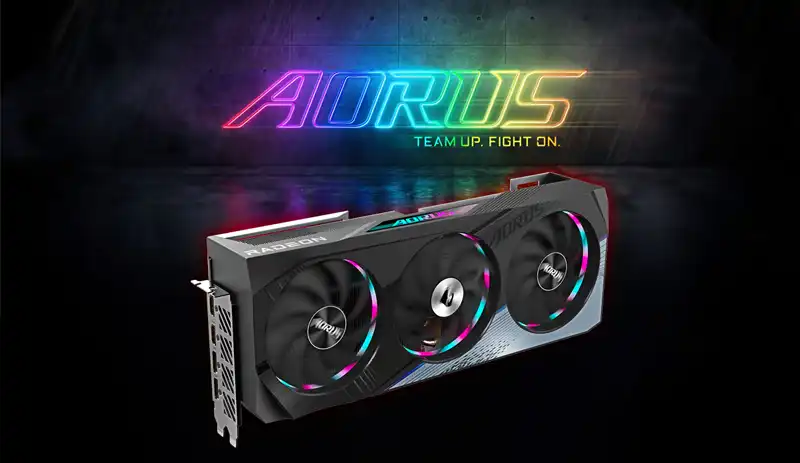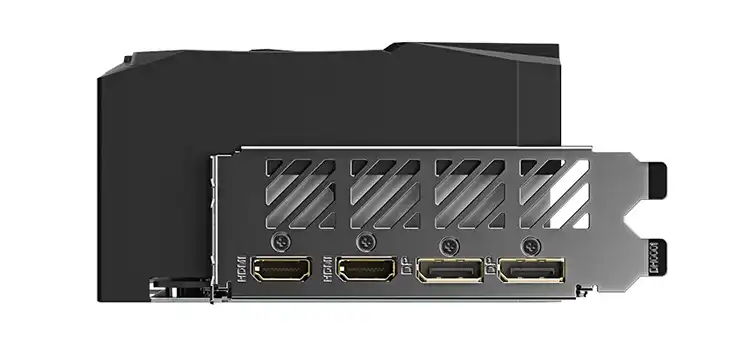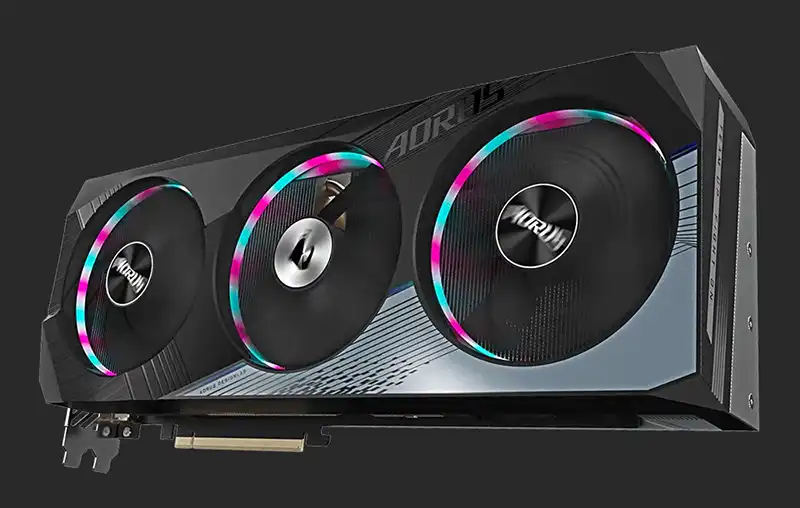You can also be interested in these:
- AMD Radeon R9 M280X GPU review: Powerful and affordable
- Gigabyte Aorus FO48U gaming monitor full review
- Gigabyte B450 Aorus Elite full motherboard review
- The Gigabyte M32Q gaming monitor – In depth review
In this review, we will evaluate the Aorus RX 7900 XTX Elite 24G graphics card, an improved version of the AMD Radeon RX 7900 XTX with a 2680 MHz boost in its RDNA 3 architecture GPU. It is Gigabyte’s most powerful card and features AMD’s most powerful graphics chip, making it compete with Nvidia’s RTX 4080 with the advantage of having better performance/price ratio. Additionally, it comes with 24 GB GDDR6 memory, a gaming aesthetic with RGB lighting and AV1 encoders for offering more options to content creators. Let’s see what it’s capable of!

External design of the Aorus RX 7900 XTX Elite 24G
The Aorus RX 7900 XTX Elite 24G graphics card comes with a high-quality Gigabyte cooler, which at 69 mm thickness is slightly slimmer than the 4080, which is good news for more compact chassis. However, it still requires 3 slots. The external casing is made of rigid plastic, similar to lower versions of the brand, but with a carefully designed 3D look and a clear gray acrylic inlay.
Of course, it comes with a good amount of RGB Fusion 2.0 lighting through the outer ring of the 3 fans and on a side area with the Aorus logo. This area is partially open to allow hot air to escape from the cooler. The front area, on the other hand, is closed and has several threaded holes for attachment to supports, including the one included.
By flipping the Windforce cooler, we find an aluminum backplate that fully covers the PCB and socket, with only an opening on the outside to maximize air flow. A fifth RGB area has been embedded in this area with the Aorus logo, providing an attractive aesthetic in both the horizontal and vertical positions of the graphics card.
Gigabyte presents 3 100 mm diameter fans with an alternating spin system in the central fan. These use graphene Nano lubricant for a durable and quiet spin system, just like in the Gaming OC versions. Additionally, it has the 3D Active Fan system, which deactivates the fans when the GPU is in standby. Finally, the card has a Dual BIOS system that allows you to set two different fan profiles, either through a button on the edge of the card or through software.
Ports and connections
The Aorus RX 7900 XTX Elite 24G has improved its video ports with the RDNA 3 graphics card range. Here they are:
- 2x HDMI 2.1
- 2x DisplayPort 2.1
The new AMD Radiance Display Engine technology allows for adoption of DisplayPort 2.1, supporting 12 bits and REC2020 color space in next-generation monitors. Furthermore, the new video interface has improved its bus to 54 Gbps to support 2K@900 Hz, 4K@480 Hz, and 8K@165 Hz monitors, surpassing HDMI 2.1.

This card features a PCIe 4.0 interface with 16 active lanes, not making the jump to Gen5 as it meets the current needs of monitors and graphic systems. The power connection remains 3 PCIe 8-pin headers, though with the power demands of the AMD Radeon RX 7900 XTX (335W TBP), a PCIe5 header would be more compact and widely used across both brands.
Heatsink and PCB
Being a custom model, we will open the Aorus RX 7900 XTX Elite 24G to see more details on its construction, heatsink, and power phase configuration. Note that this process will void the product’s warranty.
The Aorus RX 7900 XTX Elite 24G uses all its resources to ensure the best cooling possible on its most powerful model. To do this, it has a double aluminum block with vertical fins reinforced with 10 copper heatpipes for better thermal efficiency.
The block base includes a copper cold plate with a higher quality vapor chamber than the one implemented in AMD’s reference model, solving heating problems in some units due to lack of fluid.
The thermal efficiency of the Aorus is ensured by a high-quality thermal paste in contact with the GPU, along with a peripheral copper zone in contact with the GDDR6X memory chips and silicone thermal pads, and aluminum plates to cool the VRM.
The PCB of the Aorus RX 7900 XTX Elite 24G is protected with an insulating and corrosion-resistant coating. The VRM configuration has 20 power phases with Monolithic Power Systems MPS2245 MOSFETs and a Holtek controller, as well as 20 high-performance metal chokes and several filtering capacitors.
The new AMD architecture: RDNA 3 in the Radeon RX 7900 XTX
AMD’s new graphics card architecture, known as RDNA 3, allows it to compete with Nvidia in terms of performance in the high-end range. This system has undergone significant changes, the most notable being the use of chiplets instead of a single silicon, as with CPUs. Under its smooth surface, we can see a central chiplet called GCD and around 6 small chips that make up the MCD, a total of 57.7 billion transistors on a 520 mm2 surface.
The main chiplet, called GCD (Graphics Compute Die), is the largest with a size of 300 mm2 and manufactured in a 5 nm process by TSMC. It is responsible for the main computation and has 84 computation units (CU) which in turn include 84 second-generation ray tracing acceleration units, improving its performance by up to 1.8 times compared to RDNA 2 due to the cache memory and data lines.
Moreover, this chiplet also includes artificial intelligence accelerators, 2 per GCD, totalling 184 in the 7900 XTX. These units are responsible for processing instructions related to AMD FidelityFX Ray Tracing and Radeon Super Resolution. We also find 6,144 shading or Stream Processors units, 64 for each calculation unit, responsible for rendering and shading, as in other architectures. Finally, there is a total of 192 ROPs and 384 TMUs. The performance is 123 TFLOPS in FP16 and 61 TFLOPS in FP32 (compared to the 48.7 TFLOPS of the RTX 4080).
AMD is also making its move in the content creator world by including dual AV1 encoders in its GPU, capable of handling 8K resolution at 60 FPS. Being dual, they can encode and decode images simultaneously and have AI to improve image quality compared to H.264/H.265.

The capacity of the internal cache blocks has increased significantly, starting with the L0 level, which now has 64 KB blocks for each processing unit (an increase of 240%). At the L1 level, we have 256 KB cache blocks for each GPU processing complex (an increase of 300%), and as the third internal cache block, we have 6 MB shared across the entire GPU (an increase of 50%).
Infinity Cache is still used in the second generation of the Aorus RX 7900 XTX Elite 24G, but it is implemented through the MCD (Memory Cache Die), which are small chiplets surrounding the main core. Unlike the GCD, the MCDs are based on a 6 nm manufacturing process and form a total block of 96 MB with interfaces in direct communication with VRAM, allowing a transfer rate of 3500 GB/s on a 384-bit bus.
Regarding Infinity Cache, we have the VRAM memory composed of 12 GDDR6 chips totalling 24 GB working at a frequency of 2500 MHz or 20 effective Gbps. These generate 960 GB/s of effective transfer and a pixel rate of 480 GB/s (444 GP/s for the RTX 4090), surpassing the total speed of Nvidia’s GDDR6X chips. There is obviously compatibility with the Smart Access Memory (Resizable BAR) technology both on AMD and Intel CPUs.
Energy consumption
The energy consumption of this card is positioned in between the 4090 and 4080, with about 100W more than its direct rival, so in terms of power/consumption, the Nvidia architecture is more efficient. If we also stress the CPU, we will reach 710W, so it is recommended to have a PSU of at least 850W to have an additional margin in case of having a high-end CPU system. Finally, the average consumption measured by PCAT of the complete graphics card has been 42W at rest and 409W under load, with a supply of 50W in the PCIe slot.
Conclusion about the Aorus RX 7900 XTX Elite 24G
It is now clear that AMD finally has a product that not only rivals the most powerful Nvidia graphics cards, but even surpasses them. The 7900 XTX is the result of the evolution of the RDNA 3 architecture, with improvements in the chiplets, memory, and cores, which represents a significant increase in performance compared to the previous generation.
This translates into impressive performance at all resolutions and games, with solid gaming even at 8K. Additionally, it features additional features such as FSR, FidelityFX, Smart Access Memory, DisplayPort 2.1 ports and new dual AV1 encoders, giving content creators more tools. Although its consumption is higher than that of the 4080 and therefore has lower efficiency, it does not have the PCIE5 power header. On the other hand, temperatures are well controlled, although overclocking capacity is limited.
In addition, the high-quality heatsink and PCB that Gigabyte has implemented in this high-end model make it even more attractive. With a powerful VRM with top-level MOSFETs, a PCB isolated against corrosion, an excellent cooling system, and silent fans, this set is of high quality.
The price of the Aorus RX 7900 XTX Elite 24G will be approximately $1400 USD, 15% to 25% cheaper than the most powerful custom RTX 4080 models. With an average performance 1% lower than that of the 4080 and considering the results of games with the same graphic configuration, the value-for-money ratio of the AMD Radeon RX 7900 XTX is much better. Therefore, it is currently the best purchase option if you are looking to optimize your budget in the high-end range.
More stories like this
- AMD Radeon R9 M280X GPU review: Powerful and affordable
- Gigabyte Aorus FO48U gaming monitor full review
- Gigabyte B450 Aorus Elite full motherboard review
- The Gigabyte M32Q gaming monitor – In depth review
- Gigabyte Z690 Aorus Master full review
- The Gigabyte Aorus 17G XD gaming laptop full review
